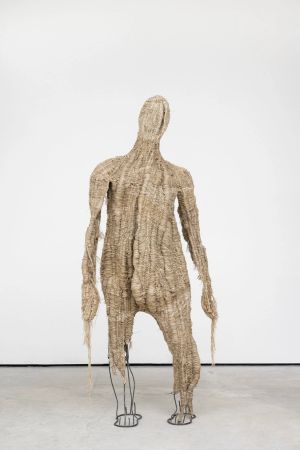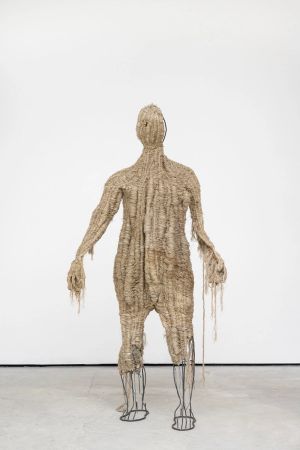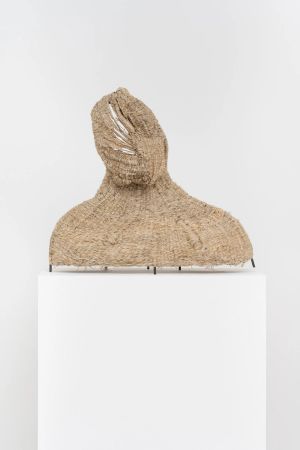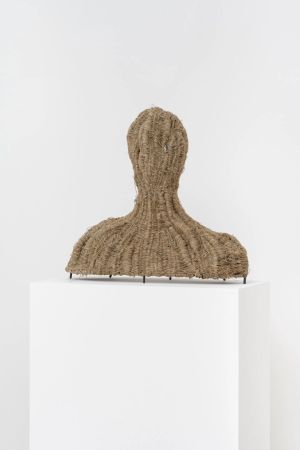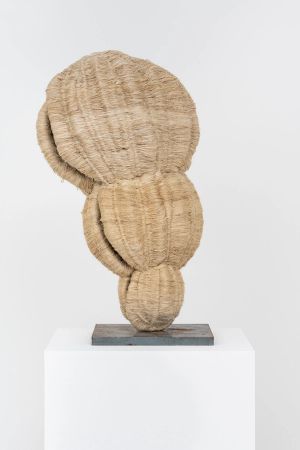GATHERING 5 Warwick Street London
Gathering is pleased to present To Be You, Whoever You Are, a solo exhibition of new textile sculpture by Korean artist Soojin Kang. Using the ritualistic actions of weaving, knotting, winding and unwinding to explore the sculptural possibilities of textiles, Kang transubstantiates raw materials into structures that retain unmistakeable traces of their biotic origins. In the artist’s hands, ‘thread is warm.’ Textiles become vascular, acting as capillaries generating the vital force of the strange organisms that she brings into being using hand-dyed linen, jute and silk. In her new body of work, Kang harnesses the animistic potential of thread to approach the human figure.
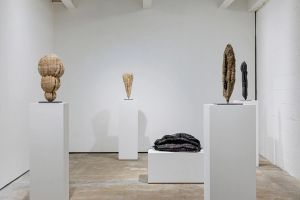
As the exhibition unfolds across both floors of the gallery, the first floor becomes an antechamber of emergent forms echoing totems and busts. Constructed from fabric wrapped, woven, bound and draped around steel armatures, the sculptures appear as relics from a horde of offerings to forgotten gods. Some resemble truncated body parts, others distended abstractions of organic matter; all stand on plinths that foreshadow the proportions of the bodies below in their scale. In the artist’s own words, the work ‘looks as if it’s been there forever,’ eliding artefact and organism like fragments of ancient statuary. As the viewer passes each work, the space becomes charged with the kind of spectral anticipation one feels when moving through a shrine or ruin.
On descending the stairs, Kang’s woven bodies come into view; from above, their scale is obscured, and forms seem to be collapsed into a tangle of sinews. At ground level, steel armatures extend into vertebrae, while fabric wrappings allude to skin, hair, bones and muscles. Among the sculptures, the viewer becomes subsumed and small, compelled to reconfigure the way in which they occupy the space. Larger than life-sized, devoid of recognisable facial features and at times disintegrating into frayed edges and knotted thread, each entity seems, at first, inscrutable and manifestly other; humanoid rather than human. However, Kang’s handling of the ability of textiles to bridge constructed divisions – between the natural and synthetic, human and organic, interior and exterior – disallows a straightforward distinction between them and us. Though imposing in their scale and impassivity, the bodies represented in these works are vulnerable. Fibrous growths cling to torsos, unravelled thread streams from a drooping head; here, the demarcation between inside and outside is messy and fragile, and emotions are embodied before they are expressed. While these presences might provoke unease, they demand the viewer’s recognition: they, like us, are creatures of affect and incompletion. In the construction of these overgrown, lichenous beings, Kang plays with the assumed lexicon commonly associated with weaving.

The artist coopts the repetitive, meditative hand labour tethered to textile production to create unruly forms that erupt into sculpture, refusing the historic designation of weaving as a subordinate art form. In doing so, Kang does not reject the persistent tethering of weaving – a process associated with care and contemplation – to notions of femininity. Instead, she works both within and against it, allowing her fascination with what she describes as ‘the minor and hidden’ to generate a new kind of monument.
Installation and Work Images by Grey Hutton








